Search Result
Results for "
gene delivery
" in MedChemExpress (MCE) Product Catalog:
23
Biochemical Assay Reagents
| Cat. No. |
Product Name |
Target |
Research Areas |
Chemical Structure |
-
- HY-144001
-
|
|
Liposome
|
Others
|
|
DSPE-PEG-Carboxylic Acid is a phospholipid PEG conjugate. DSPE-PEG-Carboxylic Acid can be widely used in the delivery of targeted agents and genes .
|
-
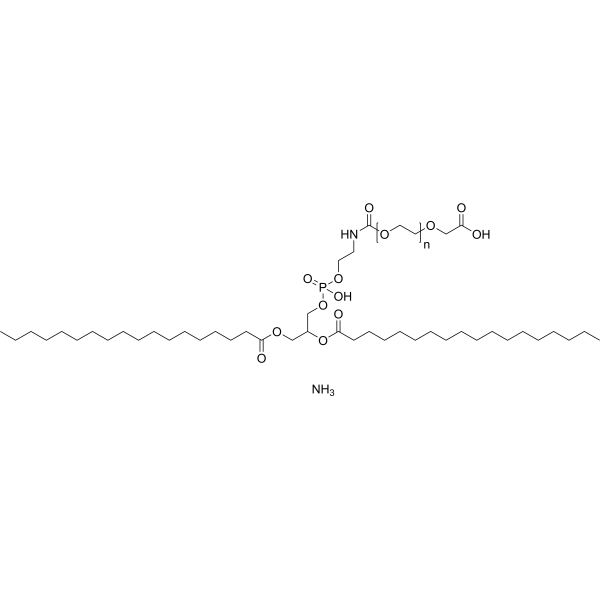
-
- HY-142995
-
|
|
Liposome
|
Others
|
|
DODAP (hydrochloride) is an ionizable lipid. DODAP (hydrochloride) has the potential for the research of gene delivery .
|
-

-
- HY-W250110B
-
|
PEI (linear, average Mn 2100, PDI<1.3)
|
Biochemical Assay Reagents
|
Cancer
|
|
Polyethylenimine (PEI) (linear, average Mn 2100, PDI<1.3), a cationic polymer, is a non-viral gene delivery vector, especially for oligonucleotide delivery .
|
-
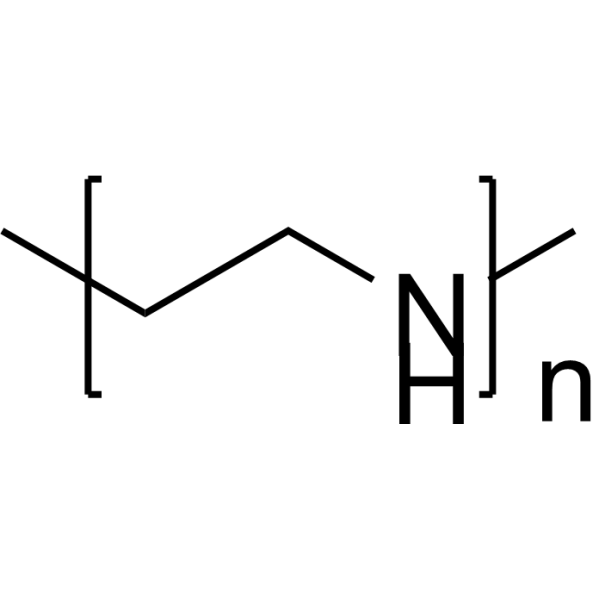
-
- HY-149664
-
|
DC-Chol
|
Liposome
|
Cancer
|
|
3β-[N-(N′,N′-Dimethylaminoethyl)carbamoyl]cholesterol, a lipid, has been investigated in cancer gene therapy and vaccine delivery system .
|
-
![3β-[N-(N′,N′-Dimethylaminoethyl)carbamoyl]cholesterol](//file.medchemexpress.com/product_pic/hy-149664.gif)
-
- HY-149037
-
|
N4-Spermine cholesteryl carbamate
|
Liposome
|
Others
|
|
GL67 (N4-Spermine cholesteryl carbamate) is a cationic lipid. GL67 can be used for nucleic acid agents and vaccines delivery, and gene transfection .
|
-
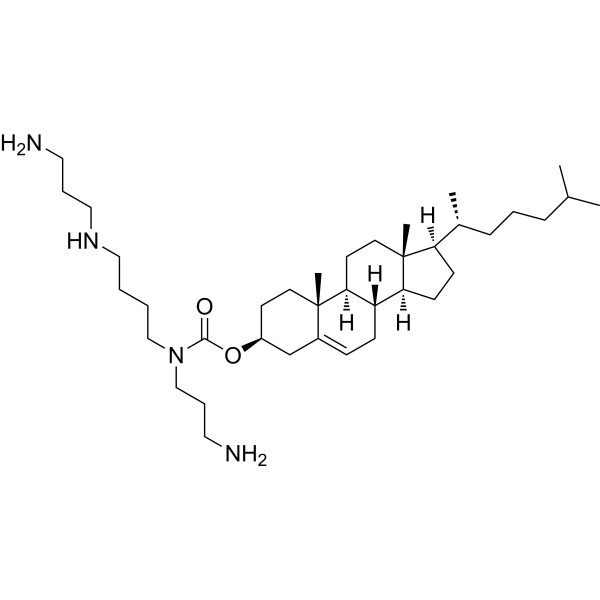
-
- HY-149037A
-
|
N4-Spermine cholesteryl carbamate pentahydrochloride
|
Liposome
|
Others
|
|
GL67 (N4-Spermine cholesteryl carbamate) (pentahydrochloride) is a cationic lipid. GL67 can be used for nucleic acid agents and vaccines delivery, and gene transfection .
|
-
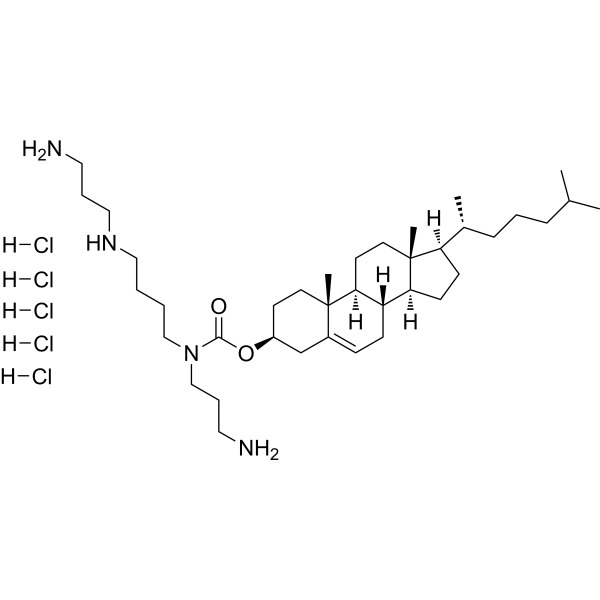
-
- HY-134783
-
|
|
Liposome
|
Others
|
|
1,19-Bis(2-butyloctyl) 10-[[3-(dimethylamino)propyl](1-oxononyl)amino]nonadecanedioate is an excipient for vaccines. 1,19-Bis(2-butyloctyl) 10-[[3-(dimethylamino)propyl](1-oxononyl)amino]nonadecanedioate can be used for the research of the development of COVID-19 vaccines and drug delivery for gene therapy .
|
-
amino]nonadecanedioate](//file.medchemexpress.com/product_pic/hy-134783.gif)
-
- HY-160576
-
|
|
Liposome
|
Cancer
|
|
DNCA is a neutral lipid that can be used in the generation of lipid nanoparticles (LNPs). DNCA can be used in nucleic acid delivery .
|
-

-
- HY-144022
-
|
|
Liposome
|
Others
|
|
16:0 DAP is a cationic lipids that can be used for drug delivery, gene transfection and vaccine delivery .
|
-

-
- HY-138170
-
ALC-0315
Maximum Cited Publications
9 Publications Verification
|
Liposome
SARS-CoV
|
Infection
|
|
ALC-0315 is an ionisable aminolipid that is responsible for mRNA compaction and aids mRNA cellular delivery and its cytoplasmic release through suspected endosomal destabilization. ALC-0315 can be used to form lipid nanoparticle (LNP) delivery vehicles. Lipid-Nanoparticles have been used in the research of mRNA COVID-19 vaccine .
|
-
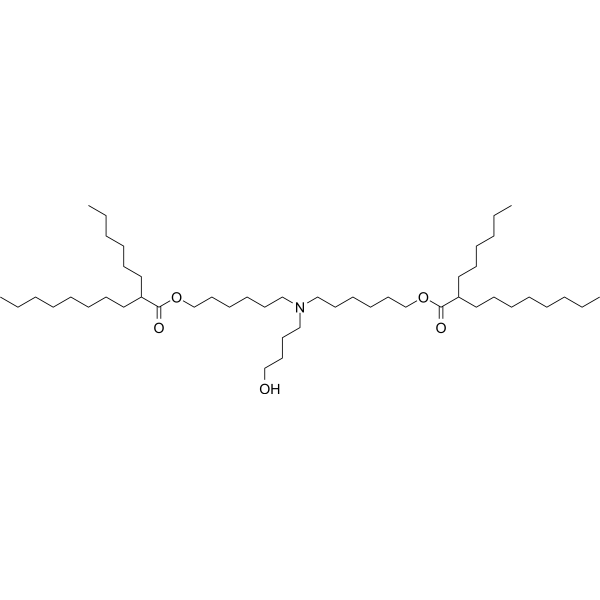
-
- HY-138170A
-
|
|
Liposome
SARS-CoV
|
Infection
|
|
ALC-0315 Excipient is an ionisable aminolipid that is responsible for mRNA compaction and aids mRNA cellular delivery and its cytoplasmic release through suspected endosomal destabilization. ALC-0315 Excipient can be used to form lipid nanoparticle (LNP) delivery vehicles. Lipid-Nanoparticles have been used in the research of mRNA COVID-19 vaccine .
|
-

-
- HY-W440827
-
|
|
Liposome
|
Cancer
|
|
DOPE-PEG-COOH (MW 2000) is a PEG-based PROTAC linker. DOPE-PEG-COOH (MW 2000) can be used in the synthesis of PROTACs. DOPE-PEG-COOH (MW 2000) can be used for drug delivery, gene transfection and vaccine delivery .
|
-
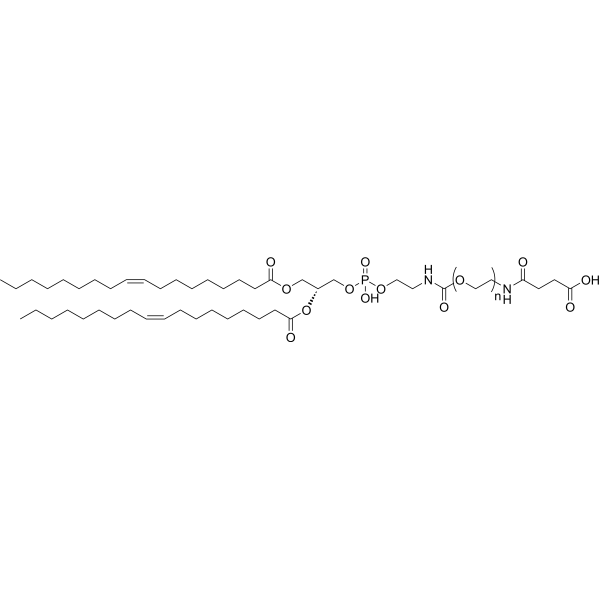
-
- HY-145523
-
|
|
Liposome
|
Others
|
|
OH-Chol is a cationic cholesterol derivative. OH-Chol can be used for siRNA delivery and gene silencing .
|
-
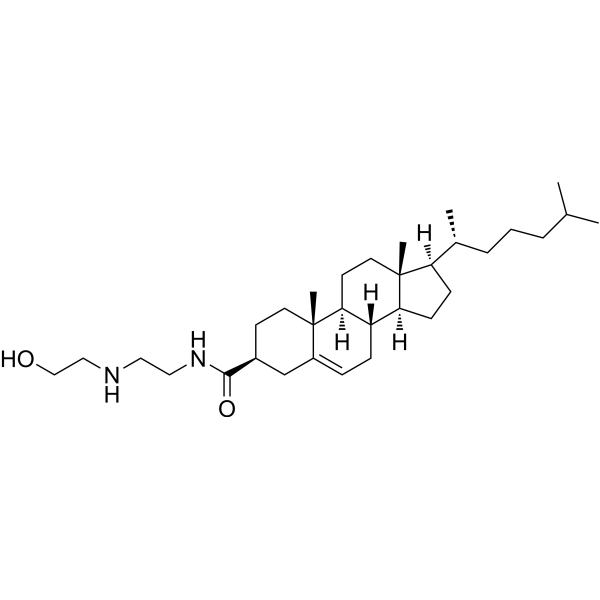
-
- HY-145794
-
|
|
Liposome
|
Others
|
|
ZA3-Ep10 is a zwitterionic lipid used in lipid nanoparticles formulation for in vivo RNA delivery and non-viral CRISPR/Cas gene editing.
|
-

-
- HY-137499
-
|
|
Liposome
Endogenous Metabolite
|
Neurological Disease
|
|
NT1-O12B, an endogenous chemical and a neurotransmitter-derived lipidoid (NT-lipidoid), is an effective carrier for enhanced brain delivery of several blood-brain barrier (BBB)-impermeable cargos. Doping NT1-O12B into BBB-impermeable lipid nanoparticles (LNPs) gives the LNPs the ability to cross the BBB. NT-lipidoids formulation not only facilitate cargo crossing of the BBB, but also delivery of the cargo into neuronal cells for functional gene silencing or gene recombination .
|
-
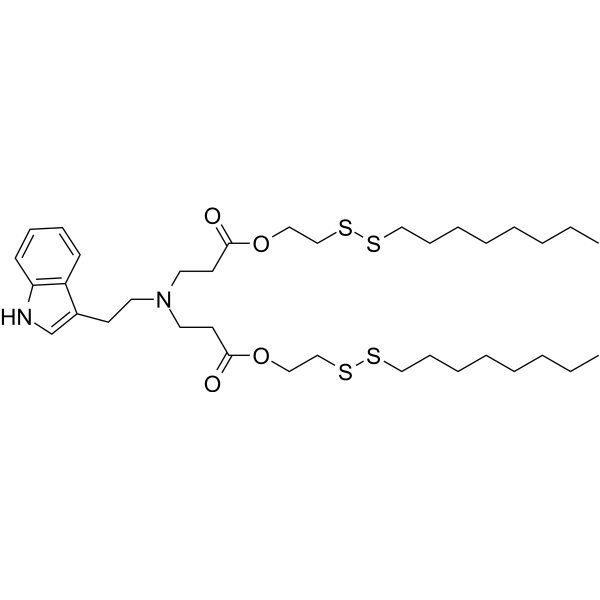
-
- HY-151513
-
|
|
Others
|
Cancer
|
|
Iso5-2DC18 is a lipid that can be used for the synthesis of amine containing lipids. These amine containing lipids can be used for mRNA delivery, activate the stimulator of interferon genes (STING) pathway, and exhibit anti-tumor immunity .
|
-
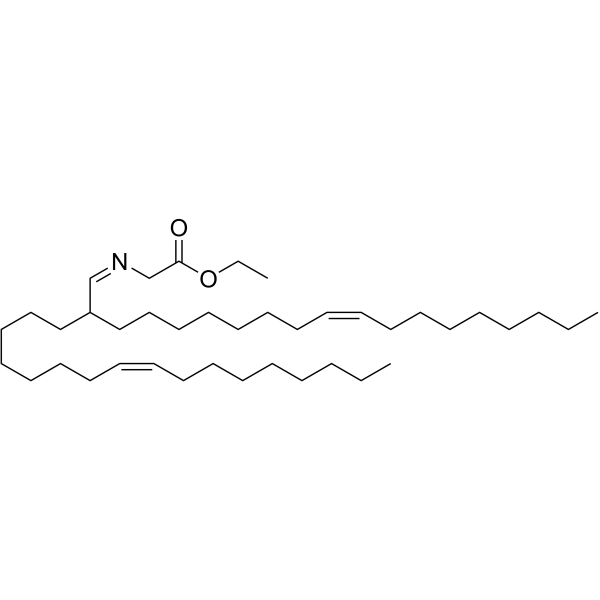
-
- HY-160852
-
|
|
Liposome
|
Inflammation/Immunology
|
|
YSK 12C4 is an ionizable cationic lipid primarily used to enhance siRNA cellular delivery via multifunctional envelope-type nanodevices (MEND). YSK 12C4 promotes siRNA uptake and endosomal escape, effectively silencing genes in human immune cell lines .
|
-

-
- HY-160581
-
|
|
Liposome
|
Others
|
|
OH-C-Chol is a cationic liposome that serves as a siRNA delivery vehicle. OH-C-Chol (LP-C) and OH-NC-Chol (LP-NC)/siRNA complexes (lipoplexes) showed better performance than NP-C and NP-NC/siRNA complexes (nanocomplexes), respectively. ) greater gene silencing effect .
|
-
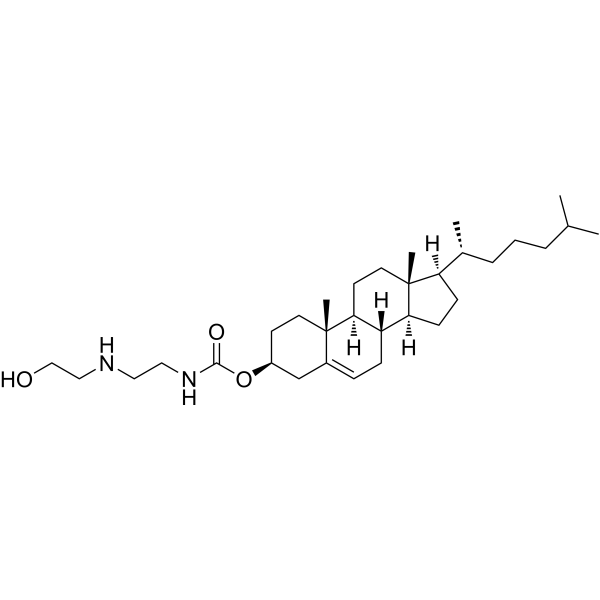
-
- HY-147087
-
|
|
Liposome
|
Cancer
|
|
YSK 05 is a pH-sensitive cationic lipid. YSK 05 improves the intracellular trafficking of non-viral vectors. YSK 05-MEND shows significantly good gene silencing activity and hemolytic activity. YSK 05 overcomes the suppression of endosomal escape by PEGylation. YSK 05 effectively enhances siRNA delivery both in vitro and in vivo .
|
-
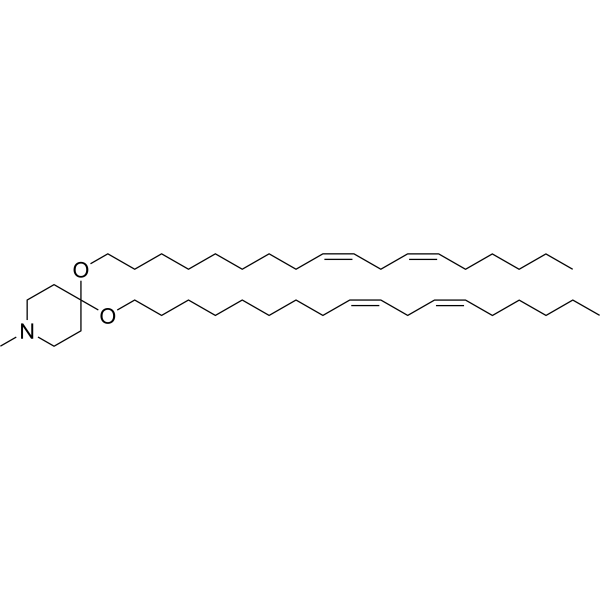
-
- HY-W591476
-
|
mPEG-SH (MW 1000)
|
Biochemical Assay Reagents
|
Others
|
|
m-PEG-thiol (MW 1000) modifies DNA thiolation for the synthesis of gold nanorods (AuNRs). Thiolated DNA can be loaded onto AuNR by the mPEG-SH/Tween 20 assisted method (Tween 20 and mPEG-SH repeatedly displace CTAB on the AuNR surface). DNA AuNRs have been widely used in nanostructure assembly, gene therapy, biosensing, and drug delivery.
|
-

-
- HY-W591476A
-
|
mPEG-SH (MW 3400)
|
Biochemical Assay Reagents
|
Others
|
|
m-PEG-thiol (MW 3400) modifies DNA thiolation for the synthesis of gold nanorods (AuNRs). Thiolated DNA can be loaded onto AuNR by the mPEG-SH/Tween 20 assisted method (Tween 20 and mPEG-SH repeatedly displace CTAB on the AuNR surface). DNA AuNRs have been widely used in nanostructure assembly, gene therapy, biosensing, and drug delivery.
|
-

-
- HY-W591476B
-
|
mPEG-SH (MW 750)
|
Biochemical Assay Reagents
|
Others
|
|
m-PEG-thiol (MW 750) modifies DNA thiolation for the synthesis of gold nanorods (AuNRs). Thiolated DNA can be loaded onto AuNR by the mPEG-SH/Tween 20 assisted method (Tween 20 and mPEG-SH repeatedly displace CTAB on the AuNR surface). DNA AuNRs have been widely used in nanostructure assembly, gene therapy, biosensing, and drug delivery.
|
-
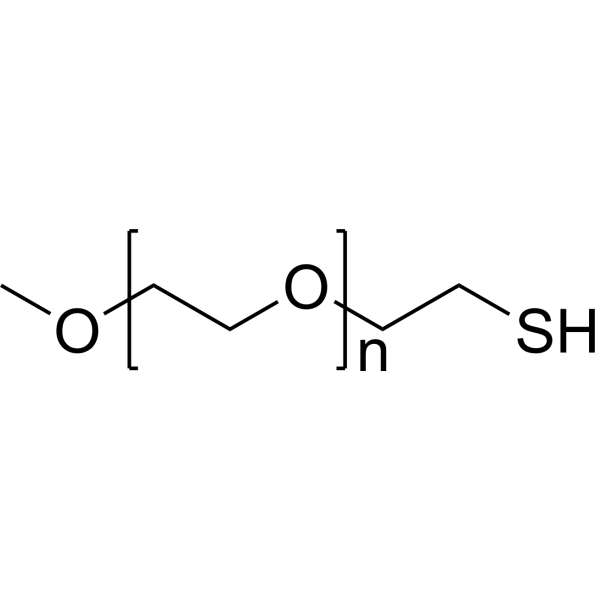
-
- HY-W591476C
-
|
mPEG-SH (MW 550)
|
Biochemical Assay Reagents
|
Others
|
|
m-PEG-thiol (MW 550) modifies DNA thiolation for the synthesis of gold nanorods (AuNRs). Thiolated DNA can be loaded onto AuNR by the mPEG-SH/Tween 20 assisted method (Tween 20 and mPEG-SH repeatedly displace CTAB on the AuNR surface). DNA AuNRs have been widely used in nanostructure assembly, gene therapy, biosensing, and drug delivery.
|
-

-
- HY-W591476D
-
|
mPEG-SH (MW 350)
|
Biochemical Assay Reagents
|
Others
|
|
m-PEG-thiol (MW 350) modifies DNA thiolation for the synthesis of gold nanorods (AuNRs). Thiolated DNA can be loaded onto AuNR by the mPEG-SH/Tween 20 assisted method (Tween 20 and mPEG-SH repeatedly displace CTAB on the AuNR surface). DNA AuNRs have been widely used in nanostructure assembly, gene therapy, biosensing, and drug delivery.
|
-
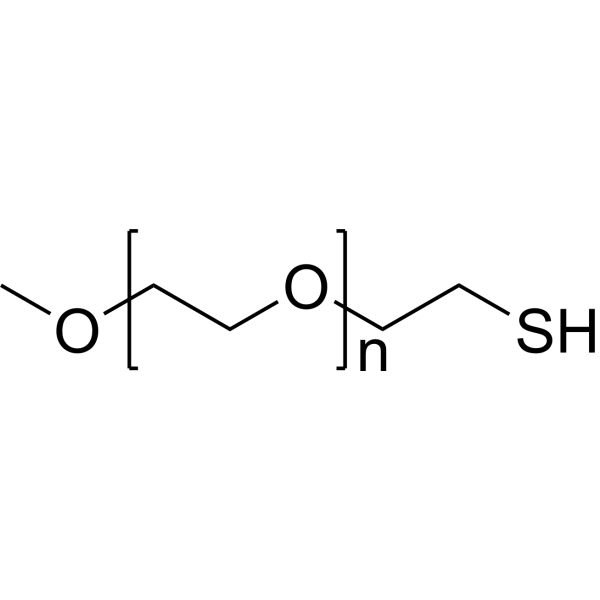
-
- HY-N3540
-
|
|
Others
|
Inflammation/Immunology
|
|
Caraphenol A is a resveratrol trimer and is able to transiently reduce interferon-induced transmembrane (IFITM) protein expression. Caraphenol A safely enhances lentiviral vector gene delivery to hematopoietic stem and progenitor cells . Caraphenol A also inhibits human cystathionine β-synthase (hCBS) and human cystathionine γ- lyase (hCSE) with IC50s of 5.9 μM and 12.1 μM, respectively .
|
-

-
- HY-153231
-
|
|
Fluorescent Dye
Liposome
|
Others
|
|
eGFP mRNA-LNP is a lipid nanoparticle (LNP) containing eGFP mRNA, suitable for assays of RNA delivery, translation efficiency, cell viability, etc. eGFP circRNA carries Enhanced Green Fluorescent Protein (Enhanced Green Fluorescent Protein) eGFP, which will express green fluorescent protein after entering the cell. eGFP is commonly used as a reporter gene detectable by fluorescence microscopy or flow cytometry .
|
-
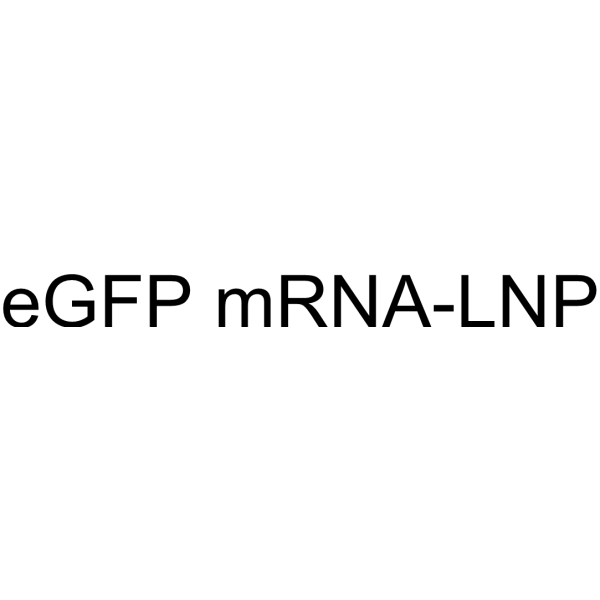
-
- HY-153232
-
|
|
Fluorescent Dye
Liposome
|
Others
|
|
eGFP circRNA-LNP is a lipid nanoparticle (LNP) containing eGFP circRNA, suitable for assays of RNA delivery, translation efficiency, cell viability, etc. eGFP circRNA carries Enhanced Green Fluorescent Protein (Enhanced Green Fluorescent Protein) eGFP, which will express green fluorescent protein after entering the cell. eGFP is commonly used as a reporter gene detectable by fluorescence microscopy or flow cytometry .
|
-
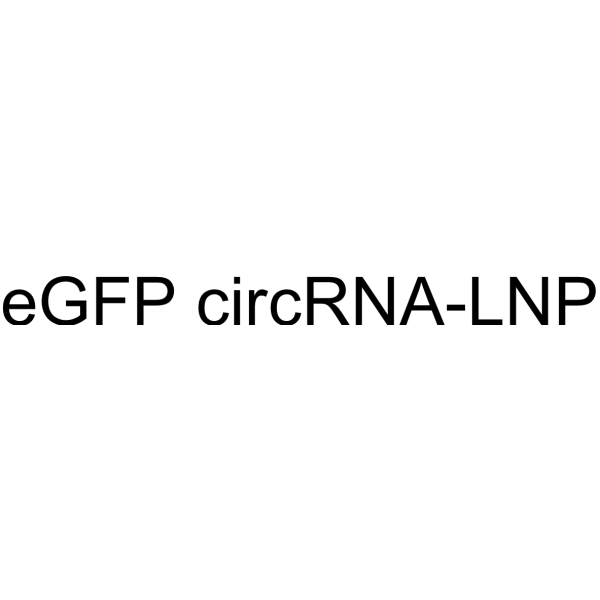
-
- HY-112758
-
|
|
Liposome
|
Others
|
|
DLin-KC2-DMA is an ionisable cationic lipid (pKa≈6) that is virtually non-toxic to antigen presenting cells (APCs). DLin-KC2-DMA produces significant siRNA-mediated gene silencing of GAPDH, when binds to lipid nanoparticles (LNP). DLin-KC2-DMA can be used in siRNA delivery studies .
|
-

-
- HY-131119
-
|
Dioctadecyldimethylammonium bromide; DODAB
|
Liposome
|
Others
|
|
Dimethyldioctadecylammonium bromide is a synthetic cationic lipid commonly used in gene delivery and vaccine development. Also known as DODAB or DDAB, it consists of a positively charged ammonium head group and two long hydrophobic tails. These properties make it useful for forming liposomes and other lipid-based nanoparticles that can efficiently deliver genetic material into cells. In addition to its applications in biotechnology, DDAB is also used in surfactants, emulsifiers and fabric softeners. However, due to its potential toxicity and irritation, extreme care should be taken when handling DDAB.
|
-
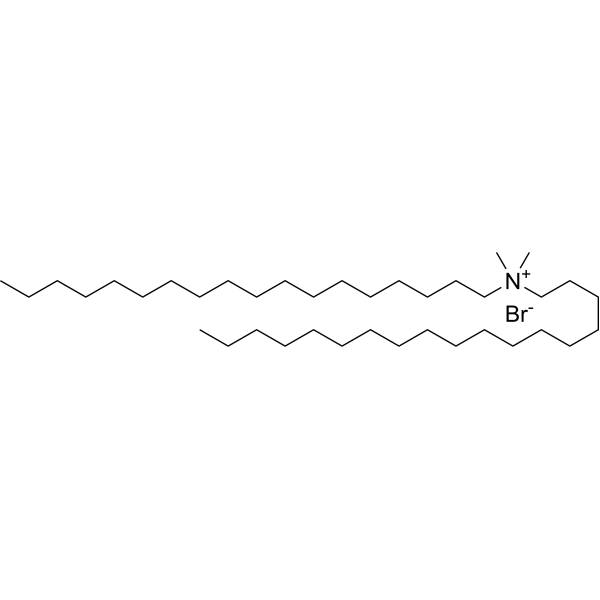
-
- HY-W250187
-
|
|
Biochemical Assay Reagents
|
Others
|
|
DDMAB, or didodecyldimethylammonium bromide, is a cationic surfactant commonly used in a variety of industrial and research applications. It belongs to the family of quaternary ammonium compounds and has a positively charged head and a hydrophobic tail, which allows it to be used as a detergent, emulsifier and antimicrobial. Known for its ability to disrupt cell membranes, DDMAB is commonly used in microbiology to selectively isolate and identify bacteria. It is also used in nanotechnology to synthesize metal nanoparticles and other materials. In addition, DDMAB has the ability to interact with and penetrate cell membranes, which has potential applications in drug delivery, gene therapy, and other medical fields.
|
-

| Cat. No. |
Product Name |
Type |
-
- HY-144001
-
|
|
Drug Delivery
|
|
DSPE-PEG-Carboxylic Acid is a phospholipid PEG conjugate. DSPE-PEG-Carboxylic Acid can be widely used in the delivery of targeted agents and genes .
|
-
- HY-142995
-
|
|
Drug Delivery
|
|
DODAP (hydrochloride) is an ionizable lipid. DODAP (hydrochloride) has the potential for the research of gene delivery .
|
-
- HY-W250110B
-
|
PEI (linear, average Mn 2100, PDI<1.3)
|
Drug Delivery
|
|
Polyethylenimine (PEI) (linear, average Mn 2100, PDI<1.3), a cationic polymer, is a non-viral gene delivery vector, especially for oligonucleotide delivery .
|
-
- HY-149664
-
|
DC-Chol
|
Drug Delivery
|
|
3β-[N-(N′,N′-Dimethylaminoethyl)carbamoyl]cholesterol, a lipid, has been investigated in cancer gene therapy and vaccine delivery system .
|
-
- HY-149037
-
|
N4-Spermine cholesteryl carbamate
|
Drug Delivery
|
|
GL67 (N4-Spermine cholesteryl carbamate) is a cationic lipid. GL67 can be used for nucleic acid agents and vaccines delivery, and gene transfection .
|
-
- HY-149037A
-
|
N4-Spermine cholesteryl carbamate pentahydrochloride
|
Drug Delivery
|
|
GL67 (N4-Spermine cholesteryl carbamate) (pentahydrochloride) is a cationic lipid. GL67 can be used for nucleic acid agents and vaccines delivery, and gene transfection .
|
-
- HY-144022
-
|
|
Drug Delivery
|
|
16:0 DAP is a cationic lipids that can be used for drug delivery, gene transfection and vaccine delivery .
|
-
- HY-138170
-
|
|
Drug Delivery
|
|
ALC-0315 is an ionisable aminolipid that is responsible for mRNA compaction and aids mRNA cellular delivery and its cytoplasmic release through suspected endosomal destabilization. ALC-0315 can be used to form lipid nanoparticle (LNP) delivery vehicles. Lipid-Nanoparticles have been used in the research of mRNA COVID-19 vaccine .
|
-
- HY-145794
-
|
|
Drug Delivery
|
|
ZA3-Ep10 is a zwitterionic lipid used in lipid nanoparticles formulation for in vivo RNA delivery and non-viral CRISPR/Cas gene editing.
|
-
- HY-137499
-
|
|
Drug Delivery
|
|
NT1-O12B, an endogenous chemical and a neurotransmitter-derived lipidoid (NT-lipidoid), is an effective carrier for enhanced brain delivery of several blood-brain barrier (BBB)-impermeable cargos. Doping NT1-O12B into BBB-impermeable lipid nanoparticles (LNPs) gives the LNPs the ability to cross the BBB. NT-lipidoids formulation not only facilitate cargo crossing of the BBB, but also delivery of the cargo into neuronal cells for functional gene silencing or gene recombination .
|
-
- HY-147087
-
|
|
Drug Delivery
|
|
YSK 05 is a pH-sensitive cationic lipid. YSK 05 improves the intracellular trafficking of non-viral vectors. YSK 05-MEND shows significantly good gene silencing activity and hemolytic activity. YSK 05 overcomes the suppression of endosomal escape by PEGylation. YSK 05 effectively enhances siRNA delivery both in vitro and in vivo .
|
-
- HY-W591476
-
|
mPEG-SH (MW 1000)
|
Drug Delivery
|
|
m-PEG-thiol (MW 1000) modifies DNA thiolation for the synthesis of gold nanorods (AuNRs). Thiolated DNA can be loaded onto AuNR by the mPEG-SH/Tween 20 assisted method (Tween 20 and mPEG-SH repeatedly displace CTAB on the AuNR surface). DNA AuNRs have been widely used in nanostructure assembly, gene therapy, biosensing, and drug delivery.
|
-
- HY-W591476A
-
|
mPEG-SH (MW 3400)
|
Drug Delivery
|
|
m-PEG-thiol (MW 3400) modifies DNA thiolation for the synthesis of gold nanorods (AuNRs). Thiolated DNA can be loaded onto AuNR by the mPEG-SH/Tween 20 assisted method (Tween 20 and mPEG-SH repeatedly displace CTAB on the AuNR surface). DNA AuNRs have been widely used in nanostructure assembly, gene therapy, biosensing, and drug delivery.
|
-
- HY-W591476B
-
|
mPEG-SH (MW 750)
|
Drug Delivery
|
|
m-PEG-thiol (MW 750) modifies DNA thiolation for the synthesis of gold nanorods (AuNRs). Thiolated DNA can be loaded onto AuNR by the mPEG-SH/Tween 20 assisted method (Tween 20 and mPEG-SH repeatedly displace CTAB on the AuNR surface). DNA AuNRs have been widely used in nanostructure assembly, gene therapy, biosensing, and drug delivery.
|
-
- HY-W591476C
-
|
mPEG-SH (MW 550)
|
Drug Delivery
|
|
m-PEG-thiol (MW 550) modifies DNA thiolation for the synthesis of gold nanorods (AuNRs). Thiolated DNA can be loaded onto AuNR by the mPEG-SH/Tween 20 assisted method (Tween 20 and mPEG-SH repeatedly displace CTAB on the AuNR surface). DNA AuNRs have been widely used in nanostructure assembly, gene therapy, biosensing, and drug delivery.
|
-
- HY-W591476D
-
|
mPEG-SH (MW 350)
|
Drug Delivery
|
|
m-PEG-thiol (MW 350) modifies DNA thiolation for the synthesis of gold nanorods (AuNRs). Thiolated DNA can be loaded onto AuNR by the mPEG-SH/Tween 20 assisted method (Tween 20 and mPEG-SH repeatedly displace CTAB on the AuNR surface). DNA AuNRs have been widely used in nanostructure assembly, gene therapy, biosensing, and drug delivery.
|
-
- HY-153229
-
|
|
Drug Delivery
|
|
Firefly luciferase mRNA-LNP is a lipid nanoparticle (LNP) containing Firefly luciferase mRNA, suitable for assays of RNA delivery, translation efficiency, cell viability, etc. Luciferase is commonly used as a bioluminescent reporter gene for gene regulation and function studies. Firefly Luciferase mRNA will express firefly luciferase protein after entering the cells, which is often used for promoter activity detection or dual fluorescent molecular complementation experiments. Common luciferase are firefly luciferase and sea kidney luciferase .
|
-
- HY-153230
-
|
|
Drug Delivery
|
|
Firefly luciferase circRNA-LNP is a lipid nanoparticle (LNP) containing Firefly luciferase circRNA, suitable for assays of RNA delivery, translation efficiency, cell viability, etc. Luciferase is commonly used as a bioluminescent reporter gene for gene regulation and function studies. Firefly Luciferase circRNA will express firefly luciferase protein after entering the cells, which is often used for promoter activity detection or dual fluorescent molecular complementation experiments. Common luciferase are firefly luciferase and sea kidney luciferase .
|
-
- HY-153231
-
|
|
Drug Delivery
|
|
eGFP mRNA-LNP is a lipid nanoparticle (LNP) containing eGFP mRNA, suitable for assays of RNA delivery, translation efficiency, cell viability, etc. eGFP circRNA carries Enhanced Green Fluorescent Protein (Enhanced Green Fluorescent Protein) eGFP, which will express green fluorescent protein after entering the cell. eGFP is commonly used as a reporter gene detectable by fluorescence microscopy or flow cytometry .
|
-
- HY-153232
-
|
|
Drug Delivery
|
|
eGFP circRNA-LNP is a lipid nanoparticle (LNP) containing eGFP circRNA, suitable for assays of RNA delivery, translation efficiency, cell viability, etc. eGFP circRNA carries Enhanced Green Fluorescent Protein (Enhanced Green Fluorescent Protein) eGFP, which will express green fluorescent protein after entering the cell. eGFP is commonly used as a reporter gene detectable by fluorescence microscopy or flow cytometry .
|
-
- HY-112758
-
|
|
Drug Delivery
|
|
DLin-KC2-DMA is an ionisable cationic lipid (pKa≈6) that is virtually non-toxic to antigen presenting cells (APCs). DLin-KC2-DMA produces significant siRNA-mediated gene silencing of GAPDH, when binds to lipid nanoparticles (LNP). DLin-KC2-DMA can be used in siRNA delivery studies .
|
-
- HY-131119
-
|
Dioctadecyldimethylammonium bromide; DODAB
|
Drug Delivery
|
|
Dimethyldioctadecylammonium bromide is a synthetic cationic lipid commonly used in gene delivery and vaccine development. Also known as DODAB or DDAB, it consists of a positively charged ammonium head group and two long hydrophobic tails. These properties make it useful for forming liposomes and other lipid-based nanoparticles that can efficiently deliver genetic material into cells. In addition to its applications in biotechnology, DDAB is also used in surfactants, emulsifiers and fabric softeners. However, due to its potential toxicity and irritation, extreme care should be taken when handling DDAB.
|
-
- HY-W250187
-
|
|
Biochemical Assay Reagents
|
|
DDMAB, or didodecyldimethylammonium bromide, is a cationic surfactant commonly used in a variety of industrial and research applications. It belongs to the family of quaternary ammonium compounds and has a positively charged head and a hydrophobic tail, which allows it to be used as a detergent, emulsifier and antimicrobial. Known for its ability to disrupt cell membranes, DDMAB is commonly used in microbiology to selectively isolate and identify bacteria. It is also used in nanotechnology to synthesize metal nanoparticles and other materials. In addition, DDMAB has the ability to interact with and penetrate cell membranes, which has potential applications in drug delivery, gene therapy, and other medical fields.
|
| Cat. No. |
Product Name |
Target |
Research Area |
-
- HY-P5284
-
|
|
Peptides
|
Others
|
|
RALA peptide is a cell-penetrating peptide. RALA peptide can be as non-viral gene delivery vectors .
|
-
- HY-126721
-
|
|
Peptides
|
Others
|
|
Tetralysine is a cationic moietie that may be used in the construction of gene delivery vectors and DNA nanoparticles .
|
-
- HY-P4250
-
|
|
Peptides
|
Others
|
|
Tetraarginine (RRRR), consisting of four arginines, is used in cell-penetrating peptide-based gene delivery vehicles .
|
-
- HY-P4250A
-
|
|
Peptides
|
Others
|
|
Arg-Arg-Arg-Arg (acetate), consisting of four arginines, is used in cell-penetrating peptide-based gene delivery vehicles .
|
| Cat. No. |
Product Name |
Category |
Target |
Chemical Structure |
-
- HY-137499
-
-

-
- HY-N3540
-
|
|
Leguminosae
Phenols
Polyphenols
Plants
Caragana sinica (Buchoz) Rehd.
|
Others
|
|
Caraphenol A is a resveratrol trimer and is able to transiently reduce interferon-induced transmembrane (IFITM) protein expression. Caraphenol A safely enhances lentiviral vector gene delivery to hematopoietic stem and progenitor cells . Caraphenol A also inhibits human cystathionine β-synthase (hCBS) and human cystathionine γ- lyase (hCSE) with IC50s of 5.9 μM and 12.1 μM, respectively .
|
-

Your information is safe with us. * Required Fields.
Inquiry Information
- Product Name:
- Cat. No.:
- Quantity:
- MCE Japan Authorized Agent:










![3β-[N-(N′,N′-Dimethylaminoethyl)carbamoyl]cholesterol](http://file.medchemexpress.com/product_pic/hy-149664.gif)


amino]nonadecanedioate](http://file.medchemexpress.com/product_pic/hy-134783.gif)

























